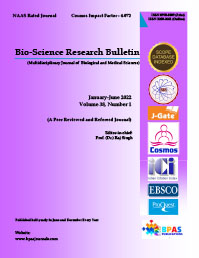Folk Medicinal Values of Plant Folia among the Ijaw Tribal Community of Bayelsa State, Nigeria
DOI:
https://doi.org/10.48165/Keywords:
Folk medicine, plant folia, conservation, Ijaw tribe, NigeriaAbstract
The study examined plant folia used in folk medicine by the Ijaw tribe of Bayelsa State, Nigeria. Plant species whose leaves were valued for folk medicine were identified through field visits and interviews of relevant stakeholders. The interviews were conducted through the use of a semi-structured questionnaire matrix. They were focused, conversational and two-way in communication. The diseases they cure and / or prevent were identified as well as their mode of administration. The results obtained revealed that 44 plant species that belonged to 31 families have their leaves valued for medicine and health maintenance in the study area. These consisted of 19 herbs, 8 shrubs and 17 trees. Field observation revealed that leaf harvesting in the identified shrubs and trees were not annihilative as the number of leaves harvested were substantially low compared to the number of leaves possessed by these plants hence harvesting was non predatory to the mother plants. However, leaf harvesting in herbs could be annihilative and predatory, especially in species with less number of individuals in the study area. The examination of the respondents’ indigenous knowledge on these species revealed that the species would thrive in the study area. Also, the species have multiple utilities values in the study area that could serve as incentives for their cultivation. Strategies that would enhance sustainable supply of the identified species were proposed.
References
Adedeji, E. D., Kayode, J., Oyedeji, A. Olanipekun, M. K.(2018). Bark Extravitism and Health Maintenance among Ijaw Tribal Community of Bayelsa State, Nigeria. Haya: The Saudi Journal of Life Sciences (In Press).
Adu- Agyem, J, Gordon, J. S., Mensah, E. (2014). Wood carving in the Akuapem Hills of Ghana: Prospects, challenges and the way forward. International J. of Business and Management Review 2, 148-177.
Ajibesin, K. K., Bala, D. N. and Umoh,U.F. (2011).The use of medicinal plants to treat sexually transmitted diseases in Nigeria: Ethnomedicinal survey of Niger Delta Region. Int J Green Pharm, 3(5), 181-191.
Anoliefo, G. O., Isikhuemhen, O. S. and Ochije, N. R. (2003). Environmental implications of the erosion of cultural taboo practices in Awka-South Local Government Area of Anambra State, Nigeria. Journal of Agricultural & Environmental Ethics16:281-296.
Appiah, F., Asibuo, J.Y. and Kumah P. 2010. “Physical and functional properties of beans flours of three cowpea (Vigna unguiculata L. walp) varieties in Ghana”. African Journal of Food Science 5 (2), 100-104.
Berkes, F., Colding, J. and Folke, C. (2000). Rediscovery of traditional ecological knowledge as adaptive management. Ecol Appl. 2000; 10:1251-1262.
Bisong, F. E. (2001). Natural resource use and conservation systems for sustainable rural development. Baaj International, Calabar.
Butler, R. A. (2005). World deforestation rates and forest cover statistics, 2000-2005. https://news.mongabay.com/2005/11/world-deforestation-rates-and-forest-cover-statistics 2000-2005/
Chigozie E. (2018). Nigerian tribes: List of major tribes in Nigeria. https://answersafrica.com/nigerian-tribes.html Assessed on 23 February 2018. 10. Kayode, J., Omotoyinbo, M. A., Ayeni, M. J. Oyedeji, A. A. (2015). Stem Barks and Roots Extravitism
In ekiti State Nigeria: Need for Conservation as a Sustainable Innovation in Healthcare Management in Rural Areas, American Journal of BioScience 3 (2), 28-33. doi: 10.11648/j.ajbio.20150302.11
Kayode, J. Ihinmikaiye, S. O., Oyedeji, A. A. and Arowosegbe, S. (2016A). The Potentials of Myths and Taboos in Forest Conservation: Could they serve as being strategies in Bayelsa State of Nigeria? Journal of Global Agriculture and Ecology 5 (1), 1-6.
Kayode J., Ihinmikaiye S. O., Arowosegbe S., Oyedeji A. A., (2016B). Conservation of Botanicals Used for Carving by the Ijaw Ethnic Group of Bayelsa State Nigeria, International Journal of Natural Resource Ecology and Management. 1(2), 58-62.
Kayode, J. Amoo, J.O. and Ayeni, M.J.(2017), “Can the Bark Extravitism among the Aboriginal Yoruba Populace of Kwara State, Nigeria, Be Sustained”. International Journal of Development and Sustainability. Vol. 6, No. (9), pp.1025-35
McDermott, M. (2009). 10 Countries with the highest deforestation rates in the World. Available:http://www.treehugger.com/corporate-responsibility/10-countries-with-the-highest Deforestation-rates-in-the-world.html
Mmom, P. C. (2007). Impacts of human density and economic activities on the mangrove forest of the Niger Delta, Nigeria. Paper delivered at the Annual Conference of the International Association for Impact Assessment, Seoul, South Korea,1-9th June; 2007.
Mmom, P. C. and Arokoyu, S. B. (2010). Mangrove forest depletion, biodiversity loss and traditional resources management practices in the Niger Delta, Nigeria. Research Journal of Applied Sciences, Engineering and Technology 2(1):28-34.
Obute, G. C. and Ebiare, E. (2008).Ethnobotanical Applications of some Floral Species in Bayelsa State, Nigeria. Ethnobotanical Leaflets 12: 713-18.
Rim-Rukeh, A., Irerhievwie, G. and Agbozu, I. E. (2013). Traditional beliefs and conservation of natural resources: Evidences from selected communities in Delta State, Nigeria. International Journal of Biodiversity and Conservation. 2013; 5(7):426-432.
Ubom , R. M. (2010). Ethnobotany and Biodiversity Conservation in the Niger Delta, Nigeria. International Journal of Botany, 6: 310-322.
WRI (1986). World Resources Basic Books, World Resources Institute, New York, USA. 21. Verpoote, R. (2012), “Good Practices: the basis for evidence – based medicines”, Journal of Ethno pharmacology, 140 (2012). Pp. 454-457.
Zabbey, N., Sam, K. and Onyebuchi, A. T. (2017). Remediation of contaminated lands in the Niger Delta, Nigeria: Prospects and challenges. Sci. Total Environ. (In Press).
